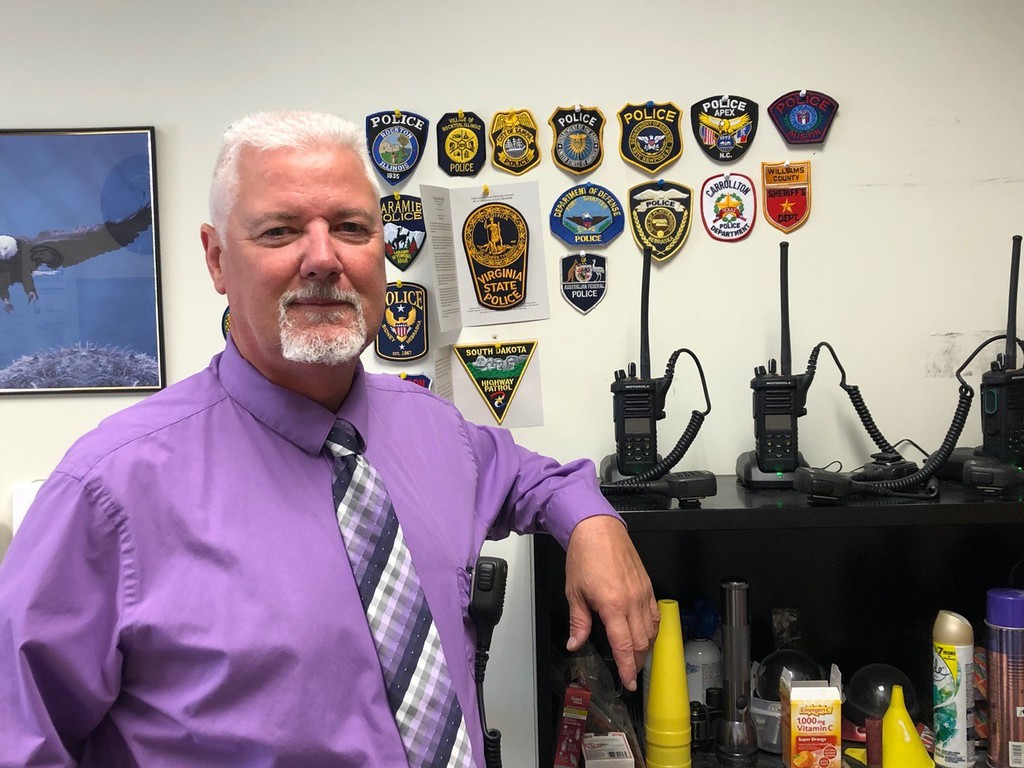Grandfather's medals led Security Supervisor to collecting

CHADRON – The cloth patches that military service members put on the shoulders of their uniforms are important symbols for soldiers and carry a wealth of historical information.
That’s the view of Mark Hunt, Chadron State College Security Supervisor, who is an avid collector of shoulder patches and other American military insignia.
The insignia on military uniforms is America’s attempt to have some connection to heraldry, Hunt said.
“We didn’t have the knights, but the symbolism is there on the shoulders of our service members,” he said.
Hunt, a former Nebraska high school teacher and coach who also worked as a police officer before coming to CSC in 2019, has become well versed in the history and value of military insignia through more than two decades of collecting. Now a regional vice president for the American Society of Military Insignia Collectors (ASMIC), he has written articles for ASMIC publications and has displayed items from his collection at the Mari Sandoz High Plains Heritage Center. An article Hunt wrote detailing the story of medals awarded to Nebraska National Guard members for service on the Mexican border in 1917 was published in the Spring 2021 issue of Nebraska History magazine.
Hunt first started collecting military insignia when he received a box of medals following the death of his grandfather, a World War II veteran. After years of searching at antique stores, flea markets, and online, his collection now comprises thousands of items. The items include shoulder patches from military units and police departments, medals, uniforms, and other items, but no weaponry or ordinance.
After starting with military medals like those from his grandfather, Hunt soon found that desired pieces were out of his price range, so he shifted to shoulder patches.
“I realized I could pick up cloth shoulder patches for a quarter or 50 cents. For 10 dollars I could get a lot,” he said.
Every person who served in the military received several patches but often thought little of their value, until years after leaving the service, according to Hunt. Collecting shoulder patches and other military insignia became more common in the years after World War II, and has grown ever since, he said.
Though initially only aware of basic information about shoulder patches, such as the unit they represented, Hunt became more interested in the history of the insignia after starting work on a master’s degree. He eventually began writing articles about what he discovered.
Most collectors now agree that the first American military unit patches date back to the Civil War, said Hunt, but the first true shoulder patches come from World War I, when soldiers began creating and wearing cloth patches in designs that represented their unit.
“The 81st Infantry Division, the Wildcat Division out of North Carolina, was really the first,” he said. “Everything was done by hand. Those guys took an old Army blanket, cut out a wildcat design, and sewed it on.”
General John J. Pershing, commander of American forces in Europe during World War I, noticed the sense of identity and pride the insignia fostered, and ordered all units in his command to have their own designs. The insignia they created often incorporated images representing the region the soldiers came from, Hunt said.
“The 36th Infantry Division, from Oklahoma and Texas, was an arrowhead with a ‘T’ in it. They still use that today,” he said.
By the time of World War II, most unit patches were machine-made and officially sanctioned, but sometimes soldiers would commission local manufacturers to make patches, which they could sell or trade to others in their unit.
“You have official and unofficial (patches),” Hunt said.
After the war ended, some German firms used their machinery to make shoulder patches for American troops, often using metal-clad thread and intricate designs. “The artwork and design is incredible.” Hunt said. “Some of those pieces could bring thousands of dollars. It depends on the workmanship and the unit.”
The Vietnam war brought more changes, including replacement of full color patches with subdued green and black designs that blended more with jungle camouflage. Official patches acquired finished edges in the 1960s, but many soldiers serving in Southeast Asia also had patches made by local workers.
“There was a plethora of unofficial patches,” Hunt said.
While many patches exist from the largest U.S. military units, like the 101st Airborne Division, others are rare, Hunt said.
Hunt doesn’t have an estimate of the value of his collection, which he has carefully organized in file cabinets, and sealed in acid-free materials to keep them from deteriorating. He takes pleasure in showing the items he has and talking about their history.
“My stuff is for people to see,” he said.
Hunt and his son, a history teacher in Malcom, Nebraska, attend trade shows that provide a chance to buy, sell, and trade with other memorabilia collectors. At shows, he sometimes gives patches away to younger children, to get them interested in history and collecting.
While Hunt believes conflict is part of human nature, he said collecting military insignia and memorabilia doesn’t imply promoting war.
“I’m not glorifying war, but I’m paying honor to those who served,” he said.
—George Ledbetter
Category: Campus News
